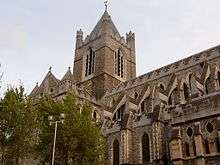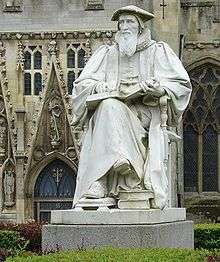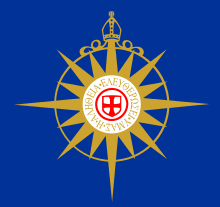Church of Ireland
| Church of Ireland | |
|---|---|
|
Eaglais na hÉireann Kirk o Airlann | |
 | |
| Classification | Protestant |
| Orientation | Anglican |
| Polity | Episcopal |
| Primates |
Richard Clarke, Archbishop of Dublin |
| Region | Ireland |
| Language | English, Irish |
| Headquarters |
Church of Ireland House Church Avenue, Dublin 6 D06 CF67 Ireland |
| Founder | Episcopal succession from Saint Patrick, according to Church of Ireland tradition |
| Members | 378,000[1] |
| Official website | ireland.anglican.org |
| Part of a series on |
| Anglicanism |
|---|
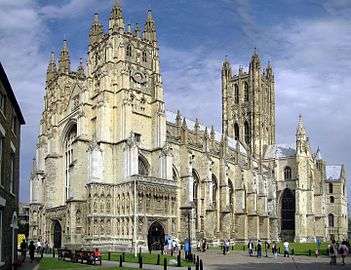 |
|
Ministry and worship |
|
|
The Church of Ireland (Irish: Eaglais na hÉireann; Ulster-Scots: Kirk o Airlann[2]) is a Christian church in Ireland and an autonomous province of the Anglican Communion. It is organised on an all-Ireland basis and is the second-largest Christian church on the island after the Catholic Church. Like other Anglican churches, it has retained elements of pre-Reformation practice, notably its episcopal polity, while rejecting the primacy of the Bishop of Rome. In theological and liturgical matters, it incorporates many principles of the Reformation, particularly those espoused during the English Reformation. The church self-identifies as being both Catholic and Reformed.[3] Within the church, differences exist between those members who are more Catholic-leaning (high church) and those who are more Protestant-leaning (low church or evangelical).[4] For historical and cultural reasons, the Church of Ireland is generally identified as a Protestant church.[5]
Overview
The Church of Ireland describes itself as
- that part of the Irish Church which was influenced by the Reformation, and has its origins in the early Celtic Church of St Patrick.[6]
The Church of Ireland considers itself Catholic because it is in possession of a continuous tradition of faith and practice, based on scripture and early traditions, enshrined in the Catholic creeds, together with the sacraments and apostolic ministry.[7] However, the Church of Ireland is also Protestant, or Reformed, since it opposes doctrines and ways of worshipping that it considers contrary to scripture and which led to the Reformation.
- The Church of Ireland, as a Reformed and Protestant Church, doth hereby re-affirm its constant witness against all those innovations in doctrine and worship whereby the Primitive faith hath been from time to time defaced or overlaid, and which at the Reformation this Church did disown and reject.[8]
When the English Parliament declared that the Holy See had no power over the Church in England, the Church in Ireland also conformed, assuming possession of most church property and so retaining a great repository of religious architecture and other items, though some were later destroyed. The church explains its possession of so many of the ancient church buildings of Ireland by reference to the precedent set by Emperor Constantine the Great in the 4th century:
Since the days of the Emperor Constantine in the 4th century European states saw themselves as having a central role in the government of the Church. This church-state link was vigorously applied when the Normans came to Ireland in the 12th century. Bishops were required to do homage to the king for their lands, just like earls and barons, who were vassals of the crown. It was therefore accepted, both during and after the Reformation, that the Crown should continue to exercise that authority over the church, in which it continued to play a central role. In this way, church property that existed at the time of the Reformation, buildings included, was retained by the Reformed, Established (state) Church of Ireland.[9]
In Ireland, the substantial majority of the population continued to adhere to Roman Catholicism, despite the political and economic advantages of membership in the state church. Despite its numerical minority, however, the Church of Ireland remained the official state church until the Irish Church Act 1869 disestablished it on 1 January 1871, under Queen Victoria and her Liberal government led by William Ewart Gladstone.
The Church of Ireland claimed that in breaking with Rome the reformed established church was reverting to a condition that had obtained in the church in Ireland prior to the 12th century – the independent character of Celtic Christianity. Modern scholarship, however, sees the early Irish church as different to but still a part of Roman Christianity, with the result that the Church of Ireland and the Irish Roman Catholic church can both claim descent from St Patrick.[10]
Claims of legitimacy for the Norman invasion of Ireland were derived from a Papal Bull of 1155 – Laudabiliter, although the governing structures in Ireland had never acknowledged any external authority over Ireland. The bull claimed to give King Henry II of England the right to invade Ireland, ostensibly as a means of reforming the church in Ireland more directly under the control of the Holy See.[11] The authorisation from the Holy See was based upon the putative Donation of Constantine which claimed to make every Christian island in the western Roman Empire the property of the Papacy, though as Ireland was never a part of the Roman Empire, it had no real relevance. By the time of the English Reformation, the Donation had been exposed as a forgery, and Henry VIII sought to undo by enforcing laws regarding praemunire the historic royal homage to the Papacy that was delivered by John, King of England before him.
The Church of Ireland is the second largest church in Ireland and the third largest in Northern Ireland, after the Roman Catholic and Presbyterian churches.
History
16th to 18th centuries
The reformed Church of Ireland was founded in 1536 when the Irish Parliament accepted Henry VIII as its head, rather than the Pope. In 1155, Adrian IV claimed Ireland as a papal fief and granted Henry II the Lordship of Ireland; in 1541, Henry assumed the title King of Ireland, effectively denying Papal supremacy in Ireland. The Irish Reformation was initially restricted to Dublin, driven by its bishop, George Browne, although when Edward VI succeeded in 1547, the pace of reform in both England and Ireland intensified. Catholicism was restored by Mary I; four bishops had to resign as they were married but the Marian period in Ireland was largely characterised by inertia.[12]
After Elizabeth replaced Mary in 1558, only five Irish bishops accepted the 1560 Elizabethan Settlement, leaving the new administration with little alternative but to replace the vast majority.[13] Doing so was complicated by the lack of Irish-speaking clergy and poverty of the Church compared to its Catholic predecessor, while some of those who remained were of relatively low quality. For example, Hugh Curwen backed the reforms of Henry and Edward, returned to Catholicism under Mary who appointed him Roman Catholic Archbishop of Dublin in 1555, before switching back to the Protestant faith under Elizabeth; he was later charged with moral delinquency by Adam Loftus, Archbishop of Armagh.
The project to convert the native Irish met with limited success in the 16th century, since
'..in order to convert the native Irish, it needed native ministers; but the supply of native ministers was meagre because the native Irish were unconverted.'[14]
A gradualist policy was adopted, similar to that used for Catholic areas in Northern England, leading to "church papist" clergy and laity.[15] This permitted nominal conformance with the established Church "whilst continuing to worship...in the traditional, pre-Reformation manner". Officially abandoned after the accession of King James VI and I in 1603, the practice of 'occasional conformity' persisted in both England and Ireland well into the mid-18th century.[16]
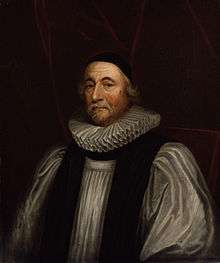
The first translation of the New Testament into Irish Gaelic was begun by Nicholas Walsh, Bishop of Ossory. This was continued after his death in 1585 by his assistant, John Kearny, and Nehemiah Donnellan, Archbishop of Tuam, completed by Donnellan's successor William Daniel and printed in 1602. A translation of the Old Testament was prepared by William Bedel, Bishop of Kilmore (1571–1642), but not published until 1685 in a revised version by Narcissus Marsh (1638–1713), Archbishop of Dublin.[17][18] William Bedell also translated the Book of Common Prayer in 1606, while an Irish version of the revised 1662 prayer book was published in 1712 by John Richardson (1664–1747).
However, the Church continued to be largely confined to the English-speaking minority in The Pale; Scots settlers in Ulster were predominantly Presbyterian, while the Irish-speaking majority retained their loyalty to the Holy See. Clergy were imported from England or Scotland, including James Ussher, later Archbishop of Armagh and primarily responsible for the Irish Articles. Similar to the Church of England's Thirty-Nine Articles drawn up by Archbishop Laud, these are more detailed, less ambiguous and often explicitly Calvinist.[19] In 1634, the Irish Parliament adopted Laud's 39 Articles in 1634 but Ussher ensured they were in addition to the Irish Articles, not a replacement. After the Restoration of 1660, the Thirty-Nine Articles were retained and remained the official doctrine of the Church of Ireland even after disestablishment.[20]
Under Charles I of England, the Church of Ireland was claimed as the original and universal church, with the Papacy being an innovation, thus vesting it with the supremacy of Apostolic succession.[21] While Rome naturally disputed this interpretation, advocates included Ussher himself and Charles' former personal chaplain John Leslie, a key supporter of Caroline reforms in Scotland who was appointed bishop of Derry & Raphoe in 1633.[22]
During the 1641-1653 Irish Confederate Wars, nearly two-thirds of Ireland was controlled by the largely Catholic Confederacy. In 1644, Giovanni Battista Rinuccini became Papal Nuncio to Ireland; however, the Confederacy also included significant numbers of Royalist members of the Church of Ireland while Irish Catholicism had developed greater tolerance for Protestants and hostility to elaborate ritual. Rinuccini's refusal to compromise with the Church of Ireland and the re-introduction of ceremonies such as foot washing divided the Confederacy and contributed to its rapid collapse in the 1649-1652 Cromwell's re-conquest of Ireland.[23]
After the end of the Williamite War in 1691, the Church re-established control; the 1697 Bishop's Banishment Act expelled all Catholic bishops and regular clergy from Ireland, leaving only the so-called secular clergy.[24]
19th to 20th centuries
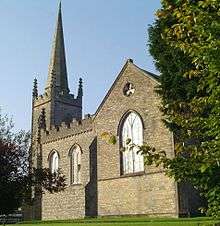
Following the legal union of Ireland and the Kingdom of Great Britain by the Act of Union 1800, the Church of Ireland was also united with the Church of England to form the United Church of England and Ireland. At the same time, one archbishop and three bishops from Ireland (selected by rotation) were given seats in the House of Lords at Westminster, joining the two archbishops and twenty-four bishops from the Church of England.
In 1833, the British Government introduced the Irish Church Temporalities Bill which proposed the administrative and financial restructuring of the church. The bill sought to reduce the number of both bishoprics and archbishoprics from 22 to 12, to change the structure of the leases of church lands and to apply the revenues saved by these changes for the use of parishes. The bill, not only had implications for the future political trajectory of the Whigs and Tories but also sparked the generation of the Oxford Movement, which was to have wide repercussions for the Anglican Communion.
As the official established church, the Church of Ireland was mainly funded by tithes imposed on all Irish subjects of the Crown. Irrespective of the fact that the adherents of the church were never more than a small minority of the populace, the population at large was expected to pay for its upkeep. Following the defeat of Roman Catholic arms in 1691, no armed resistance was to be expected to this discriminatory policy. Nevertheless, peasant resentment of the tithes occasionally boiled over, as in the "Tithe War" of 1831–36. Eventually, the tithes were ended, replaced with a lower levy called the tithe rent charge. The last remnant of the tithes was not abolished until disestablishment in 1871.
The Irish Church Act 1869 (which took effect on 1 January 1871) finally ended the role of the Church of Ireland as the state church. Disestablishment terminated both state support and parliament's role in its governance, but also took into government ownership much church property. At the establishment of the state church, no compensation had been given to Roman Catholic clergy who suffered loss in the seizure of church property by the state; at its disestablishment, compensation was provided to clergy by the state.[25] On both occasions, parishes faced great difficulty in local financing after the loss of rent-generating lands and buildings. With disestablishment, the church's representation in the House of Lords also ceased.
Governance
The head of the Church of Ireland is, ex officio, the Archbishop of Armagh. In 1870, immediately prior to its disestablishment, the Church provided for its internal government, led by a General Synod, and with financial and administrative support by a Representative Church Body. Like other Irish churches, the Church of Ireland did not divide when Ireland was partitioned in the 1920s and it continues to be governed on an all-Ireland basis.
Structure
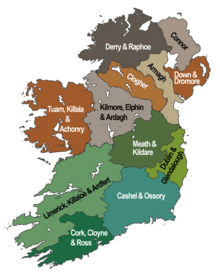
▉▉▉ Province of Armagh
▉▉▉ Province of Dublin
The polity of the Church of Ireland is episcopal church governance, as in other Anglican churches. The church maintains the traditional structure dating to pre-Reformation times, a system of geographical parishes organised into dioceses. There were more than 30 of these historically, grouped into four provinces; today, after consolidation over the centuries, there are 12 Church of Ireland dioceses or united dioceses, each headed by a bishop and belonging to one of two surviving provinces.
The leader of the southern province is the Archbishop of Dublin, at present Michael Jackson; that of the northern province is the Archbishop of Armagh, at present Richard Clarke. These two archbishops are styled Primate of Ireland and Primate of All Ireland respectively, suggesting the ultimate seniority of the latter. Although he has relatively little absolute authority, the Archbishop of Armagh is respected as the church's general leader and spokesman, and is elected in a process different from those for all other bishops.
General Synod and policy-making
Doctrine, canon law, church governance, church policy, and liturgical matters are decided by the church's General Synod. The General Synod comprises two Houses, the House of Bishops and the House of Representatives. The House of Bishops includes the 10 diocesan bishops and two archbishops, forming one order. The House of Representatives is made up of two orders, clergy and laity. The order of clergy holds one third of the seats while the laity holds two thirds of the seats.[26] As of 2017, there are 216 clergy members and 432 lay members in the House of Representatives.[27] The membership of the House of Representatives is made up of delegates from the dioceses, with seats allocated to each diocese's clergy and laity in specific numbers; these delegates are elected every three years.[28]
The General Synod meets annually, and special meetings can be called by the leading bishop or one third of any of its orders.[29]
Changes in policy must be passed by a simple majority of both the House of Bishops and the House of Representatives. Changes to doctrine, for example the decision to ordain women as priests, must be passed by a two thirds majority of both Houses.
The two Houses sit together for general deliberations but separate for some discussions and for voting. While the House of Representatives always votes publicly, often by orders, the House of Bishops has tended to vote in private, coming to a decision before matters reach the floor of the synod. This practice has been broken only once when, in 1999, the House of Bishops voted unanimously in public to endorse the efforts of the Archbishop of Armagh, the Diocese of Armagh and the Standing Committee of the General Synod in their attempts to resolve the crisis at the Church of the Ascension at Drumcree near Portadown.[30]
Statutes and Constitution
The Church's internal laws are formulated as bills proposed to the Houses of the General Synod, which when passed become Statutes. The Church's governing document, the Constitution, is modified, consolidated and published by way of Statute also, the most recent edition, the 13th, being so published in 2003.
Representative Body
The Representative Body of the Church of Ireland, often called the "Representative Church Body" (RCB), is the corporate trustee of the church, as established by law, and much of the church's property is vested in it. The members of the RCB are the bishops plus diocesan delegates and twelve co-opted members, and it meets at least four times a year. The staff of the Representative Body are analogous to clerical civil servants, and among other duties they oversee property, including church buildings, cemeteries and investments, administer some salaries and pensions, and manage the church library. While parishes, dioceses, and other parts of the church structure care for their particular properties, this is often subject to RCB rules.[31]
Orders of ministry and positions
The Church of Ireland embraces three orders of ministry: deacons, priests (or presbyters) and bishops. These orders are distinct from positions such as rector, vicar or canon.
Diocesan Governance
Each diocese or united diocese is led by its Ordinary, one of the ten bishops and two archbishops, and the Ordinary may have one or more Archdeacons to support them, along with a Rural Dean for each group of parishes. There is a Diocescan Synod for each diocese; there may be separate synods for historic dioceses now in unions. These synods comprise the bishop along with clergy and lay representatives from the parishes, and subject to the laws of the Church, and the work of the General Synod and its committees and the Representative Church Body and its committees, oversee the operation of the diocese. Each diocesan synod in turn appoints a Diocesan Council to which it can delegate powers.
Parochial Governance
Each parish has a presiding member of the clergy, assisted by two churchwardens and often also two glebewardens, one of each type of warden being appointed by the clerical incumbent, and one by popular vote. All qualified adult members of the parish comprise the General Vestry, which meets annually, within 20 days each side of Easter, as the Easter Vestry. There is also a Select Vestry for the parish, or sometimes for each active church in a parish, comprising the presiding cleric and any curate assistants, along with relevant churchwardens and glebewardens and a number of members elected at the Easter Vestry meeting. The Select Vestry assists in the care and operation of the parish and one or more church buildings.
Cathedral governance
Special provisions apply to the management and operation of five key cathedrals, in Dublin, Armagh, Down and Belfast.
Tribunals
The Church has disciplinary and appeals tribunals, and diocesan courts, and a Court of the General Synod.
Present
Membership
The Church of Ireland experienced a major decline in membership during the 20th century, both in Northern Ireland, where around 65% of its members live, and in the Republic of Ireland. The church is still the second-largest in the Republic of Ireland, with around 126,400 members in 2016 (minus 2% compared to the 2011 census results)[32] and the third-largest in Northern Ireland, with around 260,000 members.[33][34]
Cathedrals
The Church of Ireland has two cathedrals in Dublin: within the line of the walls of the old city is Christ Church Cathedral, the seat of the Archbishop of Dublin, and just outside the old walls is St. Patrick's Cathedral, which the church designated as the National Cathedral for Ireland in 1870. Cathedrals also exist in the other dioceses.
Offices, training of priests and teachers
The church's central offices are in Rathmines, adjacent to the former Church of Ireland College of Education, and the Church's library is in Churchtown. Teacher training now occurs within the Dublin City University Institute of Education, overseen by the Church of Ireland Centre, based at the former All Hallows College. The church operates a seminary, the Church of Ireland Theological Institute, in Rathgar, in the south inner suburbs of Dublin.
The Anglican Communion
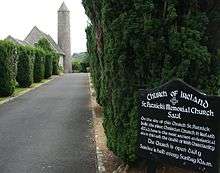
The Churches of the Anglican Communion are linked by affection and common loyalty. They are in full communion with the See of Canterbury and thus the Archbishop of Canterbury, in his person, is a unique focus of Anglican unity. He calls the once-a-decade Lambeth Conference, chairs the meeting of Primates, and is President of the Anglican Consultative Council.[35] The contemporary Church of Ireland, despite having a number of High Church (often described as Anglo-Catholic) parishes, is generally on the Low Church end of the spectrum of world Anglicanism. Historically, it had little of the difference in organisation between parishes characteristic of other Anglican provinces, although a number of markedly liberal, High Church or Evangelical parishes have developed in recent decades. It was the second province of the Anglican Communion after the Anglican Church of New Zealand (1857) to adopt, on its 1871 disestablishment, synodical government. It was also one of the first provinces to begin ordaining women to the priesthood (1991).
Relation with the GAFCON movement
GAFCON Ireland was launched on 21 April 2018, in Belfast, with 320 attendees from the Republic of Ireland and Northern Ireland. International speakers included Archbishops Peter Jensen, retired Archbishop of Sydney, and Gregory Venables, Primate of the Anglican Church of South America.[36] The Church of Ireland was represented at GAFCON III, held on 17-22 June 2018 in Jerusalem, by a six-member delegation, which included two bishops, Ferran Glenfield, of Kilmore, Elphin and Ardagh, and Harold Miller, of Down and Dromore.[37][38]
Ecumenical relations
Like many other Anglican churches, the Church of Ireland is a member of many ecumenical bodies, including the World Council of Churches, the Conference of European Churches, Churches Together in Britain and Ireland, and the Irish Council of Churches. It is also a member of the Porvoo Communion.
Flags
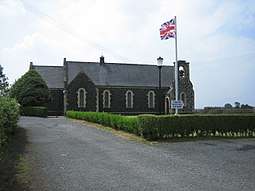
In 1999[39], the church voted to prohibit the flying of flags other than St Patrick's flag and the Flag of the Anglican Communion.[40] However, the Union Flag continues to fly on many churches in Northern Ireland.
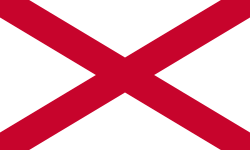
Publications
The church has an official website. Its journal is The Church of Ireland Gazette, which is editorially independent, but the governing body of which is appointed by the Church. Many parishes and other internal organizations also produce newsletters or other publications, as well as maintaining websites.
Doctrine and practice
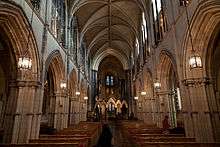
Core doctrine
The centre of the Church of Ireland's teaching is the life, death and resurrection of Jesus Christ. The basic teachings of the church include:
- Chalcedonian Christology; Jesus Christ is fully human and fully God in one person. He died and was resurrected from the dead.
- Jesus provides the way of eternal life for those who believe.
- The Old and New Testaments of the Bible ("God's Word written") were written by people "under the inspiration of the Holy Spirit". The Apocrypha are additional books that are to be read, but not to determine doctrine. The Apocrypha of the King James version of the Bible constitutes the books of the Vulgate version that are present neither in the Hebrew Old Testament nor the Greek New Testament.
- The "two great and necessary" sacraments are Baptism and the Eucharist (also called Holy Communion and the Lord's Supper).
- Those "commonly called Sacraments that are not to be counted for Sacraments of the Gospel" are confirmation, ordination, marriage, reconciliation of a penitent and unction.
- Belief in heaven, hell and Jesus's return in glory.
The 16th-century apologist, Richard Hooker, posits that there are three sources of authority in Anglicanism: scripture, tradition and reason. It is not known how widely accepted this idea is within Anglicanism. It is further posited that the three sources uphold and critique each other in a dynamic way. In Hooker's model, scripture is the primary means of arriving at doctrine; things stated plainly in scripture are accepted as true. Issues that are ambiguous are determined by tradition, which is checked by reason.[41]
Modern doctrinal debates
Ordination of women
In recent decades, the church has ordained women to all offices. In 1990 the church began ordaining women to the priesthood.[42] The first two women ordained were Kathleen Margaret Brown and Irene Templeton. In 2013, the church appointed its first woman bishop, Pat Storey.[43]
Same-sex unions and LGBT clergy
The church has been divided over aspects of human sexuality. In 2002, the issue became pertinent as a vicar provided a blessing for a lesbian couple.[44] The denomination announced a period of discernment to allocate time to the perspectives within the discussion. In 2010, a congregation was recognised by the church for receiving an LGBTI award for offering services for LGBTI people.[45]
Civil partnerships have been allowed since 2005. The church has no official position on civil unions.[46] In 2008, "the Church of Ireland Pensions Board ha[d] confirmed that it will treat civil partners the same as spouses."[47] In 2011, a cleric in the Church of Ireland entered into a same-sex civil partnership with his bishop's permission.[48][49] Assurances of sexual abstinence were not required from the cleric.[50] In 2012, the church's Clergy Pension Fund continued to recognise that "the pension entitlement of a member's registered civil partner will be the same as that of a surviving spouse."[51] Regarding cohabitation, the church said that "any view of cohabitation has to be the intention of the couple to lifelong loyalty and faithfulness within their relationship."[52] The church recognises four general viewpoints within the denomination ranging from opposition to acceptance toward same-gender relationships.[53]
Prior to the referendum on same-sex marriage, the church remained neutral on the issue.[54] In 2015, the Bishop of Cork, the Rt. Rev. Paul Colton,[55] Bishop Michael Burrows of Cashel,[56] and two retired archbishops of Dublin endorsed same-sex marriage.[57] While voting "no" on gay marriage, Bishop Pat Storey endorsed civil unions.[58] Also, 55 clergy signed a letter supporting the blessing of same-sex couples.[59] In its pastoral letter, the church reiterated that, presently, church marriages are only for heterosexual couples, but that clergy may offer prayers for same-sex couples.[60] When asked about clergy entering into civil same-sex marriages, the letter stated that "all are free to exercise their democratic entitlements once they are enshrined in legislation. However, members of the clergy, are further bound by the Ordinal and by the authority of the General Synod of the Church of Ireland."[60] Services of Thanksgiving for same-sex marriage have taken place in congregations; for example, St. Audoen's Church hosted "a service of thanksgiving" for same-sex marriage.[61] LGBTI services are also allowed by the Diocese of Cork, Cloyne and Ross.[62]
REFORM Ireland, a conservative lobby, has criticised the official letter as "a dangerous departure from confessing Anglicanism" and continues to oppose same-sex marriage recognition.[63] Reflecting division, the church deferred its report on same-sex marriage to listen to all voices.[64] The Church of Ireland Gazette, although "editorially independent", endorsed a blessing rite for same-sex couples.[65] Many congregations, including cathedrals, have become publicly affirming of LGBTI rights.[66] A church report has determined that "the moral logic underpinning the negative portrayal of same-sex eroticism in Scripture does not directly address committed, loving, consecrated same-sex relationships today".[67][68] In 2017, the General Synod considered a proposal to request for public services of thanksgiving for same-sex couples, but the proposal was not passed; the church's select committee on human sexuality recommended that the bishops continue to study the issues.[69] There were 176 votes against the motion to request public services, 146 in favour, and 24 abstentions.[70] The Bishop of Cork, Paul Colton, declared his support for same-sex marriages in the Church of Ireland.[71]
Liturgical issues
Irish language
The first translation of the Book of Common Prayer into Irish was published in 1606. An Irish translation of the revised prayer book of 1662 was published in 1712.
The Church of Ireland has its own Irish language body, Cumann Gaelach na hEaglaise ("Irish Guild of the Church" - www.gaeleaglais.ie). This was founded in 1914 to bring together members of the Church of Ireland interested in the Irish language and Gaelic culture and to promote the Irish language within the Church of Ireland. The guild aims to link its programmes with the Irish language initiatives which have been centred round Christ Church Cathedral. It holds services twice a month in Irish.[72]
From 1926 to 1995, the church had its own Irish-language teacher training college, Coláiste Moibhí. Today, there are a number of interdenominational Gaelscoileanna (schools where Irish-medium education is applied).
See also
References
- ↑ "Membership figures". churchsociety.org. Church of England Yearbook 2004. Retrieved 1 May 2016.
- ↑ 2001 Northern Irish census leaflet, Ulster-Scots NI Statistics and Research Agency. Retrieved 25 September 2012.
- ↑ "About Us", Church of Ireland website
- ↑ Church of Ireland Archived 2 April 2015 at the Wayback Machine.
- ↑ Protestant and Catholic, APCK Study Leaflet, 1996
- ↑ "What we believe" Church of Ireland official website.
- ↑ "Protestant and Catholic" Church of Ireland official website.
- ↑ "Preamble and Declaration of the Constitution of the Church of Ireland 1870, 1.3" Church of Ireland official website.
- ↑ Irish and Universal
- ↑ Thomas O'Loughlin, Journeys on the edges: the Celtic tradition,(London, 2000), Caitlin Corning, The Celtic and Roman traditions: conflict and consensus in the early medieval church (Basingstoke, 2006), Alan Ford, 'Shaping history: James Ussher and the Church of Ireland', The Church of Ireland and its past: history, interpretation and identity, ed. Mark Empey, Alan Ford and Miriam Moffitt (Dublin, 2017).
- ↑ Austin Lane Poole From Domesday book to Magna Carta, 1087–1216 Oxford University Press, 1993, pp303-304 (readable on Google books)
- ↑ Walshe, Helen Coburn (November 1989). "Enforcing the Elizabethan Settlement: The Vicissitudes of Hugh Brady, Bishop of Meath, 1563-84". Irish Historical Studies. 26 (104): 358.
- ↑ Walshe, Helen Coburn (November 1989). "Enforcing the Elizabethan Settlement: The Vicissitudes of Hugh Brady, Bishop of Meath, 1563-84". Irish Historical Studies. 26 (104): 360.
- ↑ Clarke, Aidan (1989). "Varieties of Uniformity: The First Century of the Church of Ireland". Studies in Church History (Published online 2016): 120. doi:10.1017/S042420840000861.
|access-date=requires|url=(help) - ↑ Muldoon, Andrew (2000). "Recusants, Church-Papists, and "Comfortable" Missionaries: Assessing the Post-Reformation English Catholic Community". The Catholic Historical Review. 86 (2): 248–250.
- ↑ Flaningam, John (1977). "The Occasional Conformity Controversy: Ideology and Party Politics, 1697-1711". Journal of British Studies. 17 (1): 39–41. Retrieved 10 September 2018.
- ↑ "Treasures of the Irish Language: Some early examples from Dublin City Public Libraries". 2006. Archived from the original on 9 March 2012. Retrieved 3 October 2012.
- ↑ "Bedell's Irish Old Testament". King's College London. Retrieved 3 October 2012.
- ↑ Wallace, Raymond Leslie (1949). The Articles of the Church of Ireland 1615 (PDF). University of Edinburgh; Unpublished doctoral thesis. pp. 1 - 15 passim. Retrieved 9 September 2018.
- ↑ Creeds of Christendom, with a History and Critical notes. Volume I. The History of Creeds. | Christian Classics Ethereal Library
- ↑ Richardson, Joseph (2000). "Archbishop William King (1650-1729): 'Church Tory and State Whig'?". Eighteenth-Century Ireland / Iris an dá chultúr. 15: 55.
- ↑ Diamond, Ciaran (2009). "John Leslie; 1571-1671". Oxford DNB. doi:10.1093/ref:odnb/16494. Retrieved 9 September 2018.
- ↑ Yates, Nigel. "Catholic Reformation in Ireland: The Mission of Rinuccini 1645–1649". History Ireland. Retrieved 12 September 2018.
- ↑ Simms, J.G (1970). "The Bishops' Banishment Act of 1697 (9 Will. III, C. 1)". rish Historical Studies. 17 (66): 185–186.
- ↑ Cross Denominational Mission "The Irish Church Disestablishment Act 1869 came into effect in 1871 and the Church of Ireland ceased to be the state church. This terminated both state support and parliamentary authority over its governance, and took into public ownership much church property. Compensation was provided to clergy, but many parishes faced great difficulty after the loss of rent-generating land, property and buildings."
- ↑ Dublin, Ireland, 2003: Constitution of the Church of Ireland, 1.1 The General Synod of the Church of Ireland shall consist of three distinct orders, namely, the bishops, the clergy, and the laity. / 1.2 The General Synod shall consist of two Houses, namely, the House of Bishops and the House of Representatives... / 1.3 The House of Bishops shall consist of all the archbishops and bishops of the Church of Ireland for the time being.(p1.1)
- ↑ Dublin, Ireland, 2003: Constitution of the Church of Ireland, 1.4(i) The House of Representatives shall consist of 216 representatives of the clergy and 432 representatives of the laity...(p1.1)
- ↑ Dublin, Ireland, 2003: Constitution of the Church of Ireland, 1.4-5(p1.1)
- ↑ Dublin, Ireland, 2003: Constitution of the Church of Ireland, 1.14-15 There shall be an ordinary meeting of the General Synod in every year, at such time and place as shall from time to time be prescribed in that behalf by the General Synod....(p1.3)
- ↑ Sectarianism Report Motions. Ireland.anglican.org. Retrieved on 23 July 2013.
- ↑ Church of Ireland overview (Parish Handbook)(p4)
- ↑ Census 2016 Results.
- ↑ "Census 2011: Key Statistics for Northern Ireland" (PDF). nisra.gov.uk. Retrieved 11 December 2012.
- ↑ 2011 Census, Key Statistics for Northern Ireland, December 2012, p. 19.
- ↑ Anglican Communion Official Website.
- ↑ Bringing the true Gospel of Jesus Christ to Ireland, GAFCON Official Website, 26 April 2018
- ↑ GAFCON III largest pan-Anglican gathering since Toronto Congress of 1963, Anglican Ink, 20 June 2018
- ↑ Bishop Harold reflects on his experience of the recent GAFCON conference, Diocese of Down and Dromore Official Website, 25 June 2018
- ↑ "Journal of the General Synod of the Church of Ireland 1999" (PDF). 1999: 69.
- ↑ Flags of the World: St. Patrick's Flag as flag of Church of Ireland: "The General Synod of the Church of Ireland recognises that from time to time confusion and controversy have attended the flying of flags on church buildings or within the grounds of church buildings. This Synod therefore resolves that the only flags specifically authorised to be flown on church buildings or within the church grounds of the Church of Ireland are the cross of St Patrick or, alternatively, the flag of the Anglican Communion bearing the emblem of the Compassrose. Such flags are authorised to be flown only on Holy Days and during the Octaves of Christmas, Easter, the Ascension of Our Lord, Pentecost, and on any other such day as may be recognised locally as the Dedication Day of the particular church building. Any other flag flown at any other time is not specifically authorised by this Church...."
- ↑ Anglican Listening Archived 5 July 2008 at the Wayback Machine. Detail on how scripture, tradition and reason work to "uphold and critique each other in a dynamic way".
- ↑ "Church of Ireland Ordains First Two Women Priests". Tulsa World. Retrieved 14 May 2016.
- ↑ Staff and agencies (20 September 2013). "Anglicans appoint first female bishop in UK and Ireland". the Guardian. Retrieved 14 May 2016.
- ↑ Tierney, Ciaran. "Lesbian couple get church blessing.(News)". highbeam.com. The Mirror. Retrieved 11 January 2016.
- ↑ Synod, Central Communications Board of the General. "Church of Ireland – A Member of the Anglican Communion". ireland.anglican.org. Retrieved 30 April 2016.
- ↑ O'Farrell, Michael (13 March 2016). "Church of Ireland yet to adopt official stance on same-sex partnerships". The Irish Mail on Sunday. Retrieved 22 April 2017.
- ↑ "Listening process vital to bring gay, lesbian clergy in from margins". The Irish Times. Retrieved 26 May 2017.
- ↑ "Minister Rev Tom Gordon civil partnership 'welcomed'". bbc.com. BBC. Retrieved 11 January 2016.
- ↑ "Top Church of Ireland minister reveals his same sex marriage". IrishCentral.com. 5 September 2011. Retrieved 5 November 2017.
- ↑ "Bishop under fire over cleric's gay marriage". BelfastTelegraph.co.uk. ISSN 0307-1235. Retrieved 5 November 2017.
- ↑ "Church of Ireland: Clergy Pensions Fund Explanatory Booklet" (PDF). ireland.anglican.org. Church of Ireland. April 2012. Retrieved 30 October 2016.
- ↑ "Marriage". Church of Ireland. Retrieved 23 April 2017.
- ↑ Synod), Central Communications Board of the General. "Church of Ireland – A Member of the Anglican Communion". ireland.anglican.org. Retrieved 15 May 2016.
- ↑ Ryan, Órla. "Church of Ireland won't be campaigning for same-sex marriage vote". TheJournal.ie. Retrieved 23 April 2016.
- ↑ "Same-sex marriage backed by Church of Ireland bishop – BBC News". BBC News. Retrieved 12 April 2016.
- ↑ "Gay row could 'cause Church of Ireland schism'". www.newsletter.co.uk. Retrieved 12 April 2016.
- ↑ "Archbishops and leading theologian call for Yes vote". The Irish Times. Retrieved 23 April 2016.
- ↑ "Ireland set to approve gay marriage in public vote". 10NEWS. Retrieved 12 April 2016.
- ↑ "Letter from Church of Ireland clergy in support of TEC following Primates gathering". episcopalcafe.com. Episcopal Cafe. Retrieved 1 February 2016.
- 1 2 "House of Bishops in the Church of Ireland develop a pastoral letter regarding same gender marriage in the Republic". Episcopal Cafe. Retrieved 12 April 2016.
- ↑ "Church News Ireland: Service of Thanksgiving for referendum decision" (PDF). 2 July 2015. Retrieved 18 December 2016 – via churchnewsireland.org.
- ↑ News, Latest; Irel, Photos from the Church of; Cork, Diocese of; Cloyne; Ross (16 May 2015). "St Anne's, Shandon, Cork Will Host Service for IDAHOT Day". Latest News from the Church of Ireland Diocese of Cork, Cloyne and Ross. Retrieved 19 December 2016.
- ↑ "Reform Ireland takes their bishops to task over their gay marriage pastoral letter | Anglican Ink 2016". www.anglican.ink. Retrieved 2 May 2016.
- ↑ "Same-sex marriage: Church of Ireland defers report on 'elephant in the room' – BelfastTelegraph.co.uk". BelfastTelegraph.co.uk. Retrieved 12 April 2016.
- ↑ "Church of Ireland Gazette calls for blessings for same-sex marriages". newsletter.co.uk. Newsletter UK. Retrieved 17 April 2016.
- ↑ "Other Churches supportive of LGBT Christians". changingattitudeireland.org. Changing Attitude Ireland. Retrieved 18 April 2016.
- ↑ "Church of Ireland challenged by report on homosexuality | Christian News on Christian Today". www.christiantoday.com. Retrieved 14 May 2016.
- ↑ "Guide to the Conversation on Human Sexuality in the Context of Christian Belief" (PDF). ireland.anglican.org. General Synod of the Church of Ireland. 2016. Retrieved 14 May 2016.
- ↑ "Church of Ireland delegates defeat motion on public service for same-sex couples". The Irish Times. Retrieved 6 May 2017.
- ↑ "Church of Ireland faces north-south divide over gay marriage stance - BelfastTelegraph.co.uk". BelfastTelegraph.co.uk. Retrieved 25 May 2017.
- ↑ "Cork bishop calls for same-sex marriages in Church of Ireland". 12 June 2017. Retrieved 19 June 2017.
- ↑ Church of Ireland Notes, page 2, Irish Times, 10 January 2009
- General
- Flanagan, Marie Therese (2005), "High-kings with opposition, 1072–1166", in Ó Cróinín, Dáibhí, Prehistoric and Early Ireland, A New History of Ireland, I, Oxford: Oxford University Press, pp. 899–933, ISBN 978-0-19-922665-8
Further reading
- Cross, F. L. (ed.) (1957) The Oxford Dictionary of the Christian Church. Oxford: U. P.; pp. 700–701
- Neill, Stephen (1965) Anglicanism. Harmondsworth: Penguin Books
- MacCarthy, Robert Ancient and Modern: a short history of the Church of Ireland. Four Courts Press Ltd., 1995
- The Church of Ireland: An illustrated history Booklink. 2013 ISBN 1906886563

